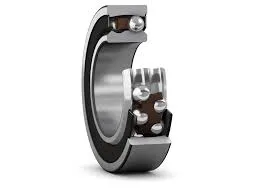
9 月 . 25, 2024 22:59 Back to list
spherical roller bearing axial load capacity
Understanding Spherical Roller Bearing Axial Load Capacity
Spherical roller bearings are a type of rolling-element bearing that is designed to accommodate both radial and axial loads. These bearings are particularly well-suited for applications where high radial loads exist, and they can also handle moderate axial loads in both directions. One of the critical aspects of spherical roller bearings is their axial load capacity, which directly impacts the performance and longevity of machinery in which they are used.
Structure and Design
Spherical roller bearings consist of an outer ring with a spherical raceway, an inner ring, and multiple rolling elements, typically in the shape of barrel-shaped rollers. This unique design allows for self-alignment, accommodating misalignments resulting from shaft deflections or mounting errors. The internal geometry of spherical roller bearings also plays a key role in their load capacity, with different designs being optimized for specific applications.
The ability of spherical roller bearings to handle axial loads is largely influenced by their design parameters. This includes the number of rollers, the roller diameter, and the angle of contact with the races. Higher numbers of rollers and larger diameters generally increase the bearing's axial load capacity. Furthermore, the internal clearance and the type of lubrication used can significantly affect the performance and load capabilities of the bearing.
Axial Load Capacity
The axial load capacity of a spherical roller bearing defines the maximum axial load that the bearing can support without failure. This capacity is influenced by several factors, including
1. Material Properties The type of material used in the manufacturing of the bearing influences its load-bearing capability. High-quality steel or ceramic materials are often selected for their strength and durability.
2. Roller Geometry The shape and size of the rollers affect the contact area between the bearing components, thus influencing the load distribution and overall capacity.
3. Bearing Series Different series of spherical roller bearings are designed for various load capacities and applications. It's crucial to select a series that meets or exceeds the expected operational loads.
4. Operating Conditions Environmental factors such as temperature, humidity, and the presence of contaminants can impact the bearing's performance. Proper sealing and lubrication are essential for maintaining optimal operating conditions and extending axial load capacity.
Calculating Axial Load Capacity
spherical roller bearing axial load capacity

The calculation of axial load capacity involves consideration of the static and dynamic factors that can impact the bearing. The dynamic load rating (C) is commonly used as a reference for evaluating the bearing's capability to sustain loads over time. For spherical roller bearings, the axial load capacity can be determined using established standards, taking into account both the dynamic and static load ratings.
Formulas such as the following help in calculating the axial load capacity (F_a)
\[ F_a = \frac{C}{X} \]
Where - \( C \) is the dynamic load rating, - \( X \) is a factor related to bearing geometry and the type of load.
Understanding these calculations enables engineers and technicians to select the appropriate spherical roller bearing for their specific application, ensuring that the bearing can reliably support the expected loads.
Applications
Spherical roller bearings are widely used in various industries, including manufacturing, construction, and mining. They are found in applications such as
- Wind turbines - Conveyor systems - Rolling mills - Crushers and separators
In these contexts, the ability to handle both radial and axial loads while maintaining high levels of performance is critical to operational efficiency.
Conclusion
In summary, the axial load capacity of spherical roller bearings is a vital consideration for engineers and designers working in numerous fields. By understanding the factors that influence load capacity, as well as the calculations and design intricacies involved, one can select the ideal bearing solution to optimize performance and prevent premature failure. Proper selection and maintenance of spherical roller bearings are essential for ensuring the reliability and longevity of mechanical systems, ultimately leading to improved productivity and lower operational costs.
Latest news
-
Unlocking Efficiency with Spherical Roller Bearings
NewsOct.29,2024
-
The Ultimate Guide to Thrust Ball Bearings
NewsOct.29,2024
-
The Power of Thrust Roller Bearings: Engineered for Excellence
NewsOct.29,2024
-
The Power of Deep Groove Ball Bearings for Your Application Needs!
NewsOct.29,2024
-
The Power and Performance of Cylindrical Roller Bearings
NewsOct.29,2024
-
High-Quality Ball Bearing Manufacturing Machines
NewsOct.29,2024
